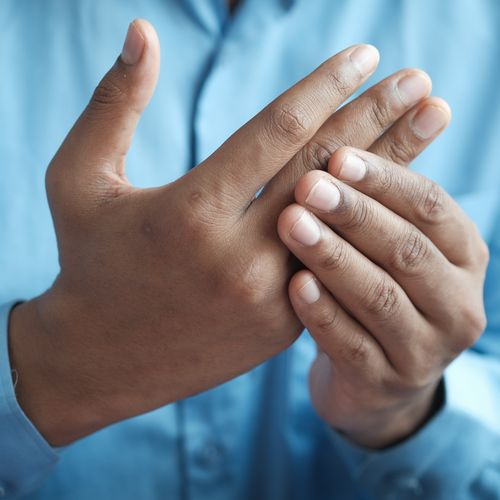The confusion between arthritis and rheumatism is understandable as, while the word has long left many medical dictionaries, “rheumatism” is still used by many people to describe symptoms similar to those experienced in osteoarthritis.
Arthritis is actually an inflammation of one or more joints in the body, though the term is used to describe virtually all problems associated with the joints.
In non-medical lay language rheumatism and arthritis both tend to be used as vague, generic descriptions for an array of joint pain and inflammation problems.
Even though the term arthritis is frequently used to refer to various problems of the joints, it is actually an inflammation of a joint or some joints in the body.
Sometimes people may refer to arthritis as rheumatism. It is a common term that people use when referring to any pains and aches in muscles, bones and joints.
Unlike osteoarthritis, a condition caused by wear and tear on joints, rheumatoid arthritis occurs when the immune system targets a person’s joint linings. Rheumatoid arthritis is a chronic inflammatory condition that also affects other tissue, but the joints are usually the most severely affected.
Rheumatism best explains a condition where no specific arthritis or any other disease is found to be the cause of the symptoms in a patient. Therefore, a rheumatic disease is any form of rheumatism, arthritis or musculoskeletal disease. These conditions number over 100; some of them are common and others are rare. Arthritis is a disease that affects anybody, whether children or adult. However, arthritis is more common in women than in men.
What Are Joints?
Joint connect one bone to another. They usually allow more free movement of bones. Cartilage is a material, which is firm and rubbery in nature and which cushions the joints at the end of bones. This cartilage tends to become more prone to damage due to injury and overuse as we age.
What Types of Arthritis and Rheumatism Are There?
Arthritis and Rheumatism are of many forms, some having to do with wear and tear (e.g. osteoarthritis) and some resulting from an overactive immune system (e.g. rheumatoid arthritis). The following are the most common forms of rheumatic diseases:
- Back pain – this problem is common and may result from many conditions
- Carpal Tunnel Syndrome
- Fibromyalgia – this is a type of soft tissue rheumatism
- Gout – this is a type of inflammatory arthritis
- Juvenile arthritis
- Osteoarthritis – of all forms of arthritis, this is the most common
- Rheumatoid arthritis (RA) – this is another type of inflammatory arthritis
- Systemic lupus erythematosus (SLE) or lupus for short
What Are the Symptoms of Arthritis and Rheumatism?
Symptoms expressed by arthritis or rheumatism patients are dependent on the particular type of arthritis or rheumatism the person is suffering from.
Nevertheless, these are symptoms that are indicative of arthritis or rheumatism:
- Constant or frequent pain in a joint that has no obvious cause.
- Joints appearing red and warm to the touch.
- Stiffness around the joints.
- Sudden difficulty in moving or using a joint.
- Swollen joint(s).
Arthritis or rheumatism is not limited to some joints in the body, it can affect any joint. But the most commonly affected joints are those of the hips, knees and fingers. Rheumatoid arthritis often comes with a mild fever and loss of energy or appetite. The symptoms of arthritis are more severe in the morning and during cold weather. Movement of affected joints may give a click or crack sound.
How Will Arthritis and Rheumatism Affect Me?
Here, the type of arthritis or rheumatism you suffer is also the determinant. You may suffer it for years or it may just be for few months, after which you will recover ordinarily or after some treatments. Your doctor may be unable to tell you the actual course your own arthritis or rheumatism would take.
Am I at Risk of Getting Arthritis and Rheumatism?
No age group, sex or race is exempted from being affected by arthritis. Nevertheless, the following conditions puts you at a higher risk:
- A member of your family suffers from the disease.
- You are a woman.
- You have sustained injuries from work related activities or sports repeatedly (Sports stars are prone to arthritis).
Is There Anything That I Can Do to Prevent Getting Arthritis and Rheumatism?
Although, there is no direct way of preventing arthritis, maintaining a healthy diet and getting enough exercise on a regular basis will stop weight gain and also prevent joint stiffness.
How Are Arthritis and Rheumatism Diagnosed?
Your medical history and symptoms are the basic information that will help your doctor to determine your arthritis/rheumatism status. There are a lot of cases also, where arthritis condition is diagnosed by physically examining the joints. Physical examination is more common when a large joint is affected. Further testing of blood may be required to determine the type of arthritis. Examination of the affected joint using an x-ray is also part of the diagnosis process.
How Are Arthritis and Rheumatism Treated?
Most types of arthritis are not curable. Treatments are usually to help the patient continue with his/her normal life. Treatment also depends on the type and severity of the arthritis condition. Some patient may be fine after a simple routine of daily exercise to lessen the pain and help improve joint movement. Soft tissue rheumatism often leaves the patient soon with or without treatment.
For pains in the joint, there are drugs that will help to relieve the pain and also reduce inflammation around the affected joint. The drugs will belong to one of these three categories:
1. Analgesics (pain killers). An example is Paracetamol, which helps to relieve pain. You can get this at any chemist.
2. Non-steroidal anti-inflammatory drugs (NSAIDs). Examples include ibuprofen and aspirin, which are also available for purchase at chemists. You can also get stronger NSAID’S to be prescribed by your doctor. Their effect is usually felt within few hours after use. They reduce pain and inflammation. Nevertheless, the extended administration may result in stomach problems.
3. Steroids, usually cortisone can be administered in tablet form or injected directly into the affected joint to relieve the pain immediately. Extended use of steroids can lead to some side effects. Hence, they are usually only recommended for controlling severe arthritis.
Disease-modifying drugs are usually given to patients with rheumatoid arthritis to help slow down the progress and reduce inflammation.
Exercises are generally good for arthritis patients. Once diagnosed with any form of arthritis, it is best to consult your doctor for the type of exercise that is suitable for your condition. Swimming often answers the question here. A physiotherapist is another good option that your doctor can recommend you to visit. They can help to give acupuncture, massages, recommend exercises and also teach you ways of relaxing to reduce muscle tension and stress.
In cases where the arthritis is not responding to treatments, a surgical operation to replace affected joint may be recommended. There have been countless successes with knee, hip, and finger joint replacements.
Photo by Towfiqu barbhuiya on Unsplash
Zoom Health is a leading UK supplier of Home Health Tests and Earplugs





